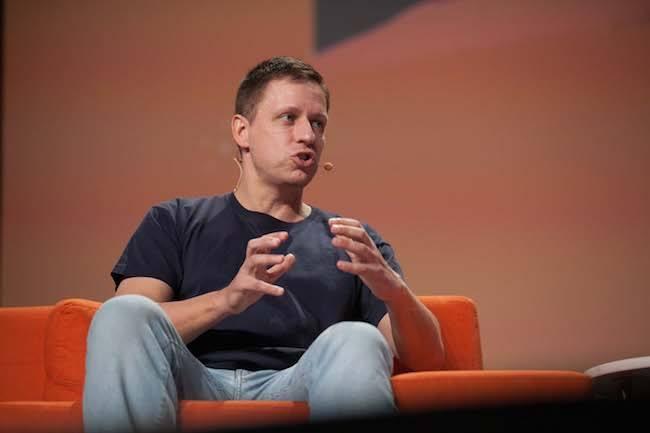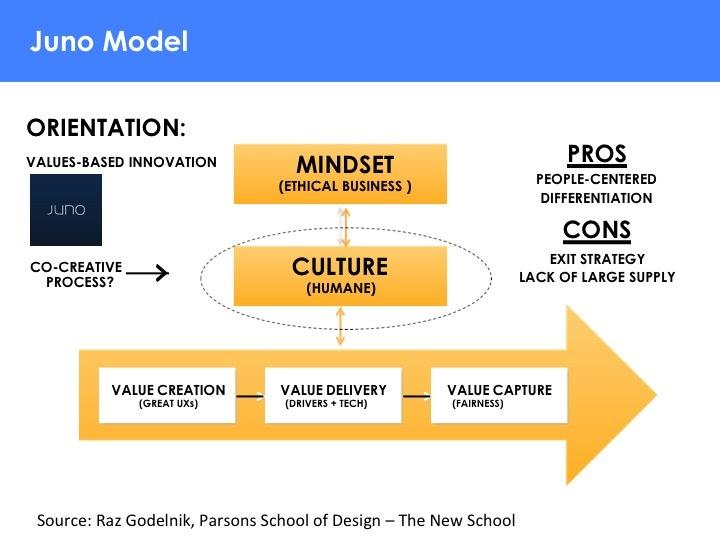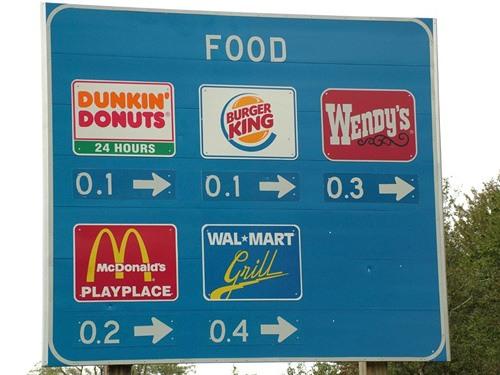3p Weekend: 10 Companies Offering Paid Family Leave to All Employees


With a busy week behind you and the weekend within reach, there’s no shame in taking things a bit easy on Friday afternoon. With this in mind, every Friday TriplePundit will give you an easy read on a topic you care about. So, take a break from those endless email threads and spend five minutes catching up on the latest trends in sustainability and business.
The United States remains the only industrialized nation that does not mandate paid family leave for all workers. Thankfully, some companies are beginning to take matters into their own hands -- not only because it's the right thing to do, but also because it makes good business sense.
"When employees are able to take paid leave, they’re less stressed at work and are able to come back feeling refreshed, both of which are good news for employee efficiency and thus the bottom line," Richard Eidlin, vice president of public policy and business engagement for the American Sustainable Business Council, wrote in an op/ed on TriplePundit.
Despite these benefits, only 13 percent of workers in the private sector have access to paid parental leave, according to the U.S. Department of Labor. And by far, most of them are white-collar, salaried workers.
These 10 companies are bucking this trend by offering all employees paid leave to care for a new child or a sick family member. You may notice one thing they all have in common: They're remarkably successful for their industries. Coincidence? You decide.
1. Netflix
The online streaming service now available in over 190 countries made waves last year with a surprising announcement: It would extend unlimited family leave to all salaried employees. New moms and dads can take off work indefinitely for the first year after a child's birth or adoption, with the option to return to full- or part-time work and then take leave again as needed.
Hourly workers also receive paid time off following the birth or adoption of a child, albeit not as generous as the company's unlimited policy. Hourly employees in the company's streaming department are eligible for 16 weeks paid maternity or paternity leave. Employees in the DVD department are eligible for 12 weeks, while customer service employees receive 14 weeks.
2. Spotify
Not to be outdone by its counterpart in the streaming biz, Spotify announced its own paid family leave upgrade last year. The music streaming company took a page from its Swedish founders' handbook and now offers six months paid family leave to all new parents -- mothers and fathers, hourly and salaried, adopted or birth.
3. Deloitte
In September, Deloitte launched what it calls the most extensive new family leave policy in the professional services industry. The new policy will allow all male and female employees to take up to 16 weeks of paid time off to care for a family member, such as a new child, a spouse or an aging parent.
Under the new policy, birth mothers are now eligible for up to six months of paid time off when factoring in short-term disability, Fortune reported.
4. Hilton
The latest on the family leave bandwagon, Hilton opted to extend its policies last week. Under the new policy, all employees can take up to 10 weeks of fully paid leave following the birth or adoption of a child, NPR reported.
While lower-wage, hourly workers are often left out of paid leave, Hilton went full-boar and extended its policies to all 40,000 team members -- from cooks and housekeepers to corporate executives.
5. Nike
Earlier this year, footwear and apparel giant Nike undertook a much-needed expansion of its paid family leave policy. Its former policy did not extend family benefits to hourly workers, new fathers or adoptive parents. And birth mothers only received six weeks paid time.
Under the new policy, all full-time employees (30 hours or more per week) are eligible for eight weeks paid family leave, Reuters reported in May. This includes new fathers, adoptive parents and employees who need to care for a sick family member. Birth mothers are now eligible for 14 weeks paid time, with the option to extend as medically necessary and recommended by a doctor.
6. Adobe
At the start of next month, Adobe will introduce its new family leave policy to all employees. Under the new policy, all employees are eligible for the following, according to the software giant:
- Medical Leave: Up to 10 weeks of paid time for surgery, childbirth, a medical emergency or illness.
- Parental Leave: 16 weeks of paid time for primary caregivers. This includes moms and dads who become parents through childbirth, surrogacy, adoption or foster care.
- Maternity Leave: Through the combination of Medical and Parental Leave, birth mothers will receive up to 26 weeks of paid time.
- Family Care Leave: Provides employees up to four weeks of paid time to care for a sick family member.
7. ZestFinance
Financial technology company ZestFinance is determined to stay on the cutting edge -- and that includes its benefits package for employees. At the start of this year, the company announced a new set of benefits that extend paid family leave to all workers.
Under the new policy, primary caregivers are eligible for six months of paid leave, with the option to work part-time for six additional months will full benefits. New secondary caregivers can take up to three months of paid time.
The new policy is part of ZestFinance's quest for a truly diverse and inclusive workforce. It's concurrent with the company's goals to increase minority diversity by 25 percent and achieve gender parity in its workforce, a goal it achieved for its C-suite last year.
8. Coca-Cola
Coca-Cola expanded its paid family leave earlier this year -- and said its millennial employees are largely to thank. As of next year, the company will offer six weeks of paid leave to all new parents in the U.S., including moms and dads who come to the role through birth, adoption or foster arrangements.
The policy includes hourly workers but comes with one caveat -- only non-bargaining (i.e., non-union) employees can take part.
9. Amazon
Last year, an Amazon representative sent an email to Bloomberg BNA to announce its new paid family leave policy. Moving forward, Amazon is offering up to 20 paid weeks paid leave for new mothers, consisting of four weeks of paid pre-partum medical leave, followed by 10 weeks of paid maternity leave and six weeks of paid parental leave.
Those six weeks of parental leave are also available to new fathers and “all other new parents who have been at Amazon for a year or more,” the company told Bloomberg.
10. Etsy
After going public last year, many worried that Etsy -- a certified B Corp and self-proclaimed social responsibility leader -- would change its tune to suit Wall Street. But that doesn't seem to be the case, at least when it comes to paid family leave.
Beginning in April, the peer-to-peer e-commerce company began offering all employees 26 weeks of fully paid leave when they become a parent through birth or adoption, regardless of their gender.
“When my wife and I adopted our son nearly four years ago, I took the full five weeks of leave we offered at the time,” Etsy CEO Chad Dickerson said in a statement in March. “It was the most important way I could have spent that time. Building a company is a team effort that includes the immense support we get from our families. I’m excited that our new leave policy will strengthen families and, as a result, the company as a whole.”
Image courtesy of Netflix (press use only)
Zuckerberg: Peter Thiel Brings Diversity to Facebook Board


It's been a wild year for Silicon Valley tycoon Peter Thiel. The Facebook board member and co-founder of PayPal has been in the media spotlight since last May, when he was revealed to have poured $10 million of his own money into the notorious Hulk Hogan "sex tapes" lawsuit against Gawker Media. Right around the same time, Thiel's name popped up on the list of California delegates in support of Donald Trump's ultimately successful run for the Republican Party presidential nomination.
Unfortunately for Thiel -- and Facebook -- both of these circumstances link him with two rather unsavory outcomes. The Hogan lawsuit has been widely excoriated as a heavy-handed (and successful) attempt to quash a news organization, a threat to the first amendment's freedom of the press, and the Trump campaign has been widely condemned for its affinity with racism, sexism, fascism and xenophobia.
Peter Thiel has some 'splaining to do
Though Trump handily won the Republican nomination, his support within his own party was weak from the beginning and it is now in a state of almost total collapse. That's partly due to his proclivity for making overtly racist statements and attracting racist supporters, including prominent leadership in the Ku Klux Klan and the so-called alt right movement.
As a result, Trump has garnered practically zero support from African-American voters. He has also willfully antagonized Mexicans and other immigrants, all Muslims (American citizens or not), Jews and women.
Through all this, Thiel has continued to express his steadfast support for Trump. However, he has done so in a way that protects himself from public discourse.
If recent news is accurate, Peter Thiel cemented his dedication to Donald Trump just last week, with a reported $1.25 million donation to the Trump campaign as it heads down the home stretch.
Following Thiel's pattern of non-disclosure, no public statement accompanied reports of the donation, which was apparently Thiel's first monetary contribution to the Trump campaign.
In sum, Thiel has played a significant role in enabling the candidacy of Donald Trump, and yet he has declined any responsibility to explain his position in an open discussion with any news organization, or in any other format.
Thiel's continued support for Trump has left Facebook in an awkward position.
After all, Facebook's business model is based on connecting humanity on an equal footing, regardless of race, gender, religion, nationality or station in life. All you need is an Internet hookup and Bob's your uncle.
Nevertheless,Thiel has not once engaged in a public conversation about his choice of candidate.
Facebook's Mark Zuckerberg steps up
Facebook has also been reluctant to engage the public in a discussion about board member Thiel's support for Trump, but apparently some employees have been questioning the relationship.
In response, Facebook co-founder and CEO Mark Zuckerberg posted a note to employees on an internal message board, to explain why Thiel has not yet been booted off the board.
Fortune Magazine has graciously provided a screenshot of the message, which first appeared on Hacker News. Zuckerberg leads off with this:
I want to quickly address the questions and concerns about Peter Thiel as a board member and Trump supporter.
We care deeply about diversity. That's easy to say when it means standing up for ideas you agree with. It's a lot harder when it means standing up for the rights of people with different viewpoints to say what they care about. That's even more important.
Forbes goes on to cite this passage:
“We can’t create a culture that says it cares about diversity and then excludes almost half the country because they back a political candidate,” wrote Zuckerberg. “There are many reasons a person might support Trump that do not involve racism, sexism, xenophobia or accepting sexual assault.”
The problem is that in this context, Zuckerberg strips any consequential meaning from the word "diversity."
Respecting diversity does not necessarily require respect for speech and actions that by any reasonable measure are racist, misogynistic, xenophobic, or which otherwise express a social outlook that is far out of step with an environment that aspires to tolerance and inclusion.
Those expressions are, in fact, the ones that are intolerant of diversity.
Zuckerberg's argument boils down to this: confronting racism is a form of racism.
More defense for Thiel
Coincidentally or not, Zuckerberg's post appeared right around the time The Week published an op-ed defending Thiel under the title, "Silicon Valley's Shameful Purging of Peter Thiel."
It was written by Pascal-Emmanuel Gobry, whose byline describes him as a "writer and fellow at the Ethics and Public Policy Center."
According to the watchdog organization Sourcewatch, since its founding in 1976 EPPC has "functioned as the cutting edge of the neoconservative-driven culture war against progressive theology and secularism, and the associated effort to ensure right-wing control of the Republican Party."
If you are assuming that the EPPC platform shapes Gobry's defense, you will not be disappointed.
Here's his lede:
If there are saints in the church of secular progressivism, the Hollywood Ten are surely among them.
Gobry goes on to argue that Thiel is facing the same kind of witch hunt that occurred during the height of the 1950's anti-Communist witch hunts, which destroyed the careers of writers and other professionals.
However, Gobry overlooks a critical difference. The Hollywood Ten and other purported communists faced the full wrath and power of the federal government, under the instigation of U.S. Senator Joe McCarthy.
So far, Thiel has faced only the judgement of his peers in business.
In fact, Gobry's main complaint is not over any harassment of Thiel by the government. Gobry zeroes in on venture capitalist Ellen Pao, who earlier this week announced that her pro-diversity group Project Include would drop its relationship with startup funder YC, where Peter Thiel is described as a "part time, unpaid partner."
In a powerful essay, Pao describes Thiel's $1.25 million donation as the last straw in a list of questionable choices.
On his part, YC president Sam Altman has defended the Thiel relationship (while endorsing Hillary Clinton for president) along the same lines that Zuckerberg has taken:
The way we got into a situation with Trump as a major party nominee in the first place was by not talking to people who are very different than we are. The polarization of the country into two parallel political realities is not good for any of us. We should talk to each other more, not less.
Zuckerberg and Altman assume that "talking to people" will fix things, but they seem to assume that the repair will favor tolerance. That would be a pleasant outcome, but it is not necessarily the only outcome.
The Republican Party has been talking to people who are "very different" for a while now, and look where they ended up.
Zuckerberg has a right to defend Thiel. Many others, like Pao, have a right to disassociate themselves from someone presents a clear threat to a tolerant, civil society.
Pao sums it up (emphasis hers):
We agree that people shouldn’t be fired for their political views, butImage credit: Peter Thiel on March 3, 2015 by JD Lasica via flickr.com, creative commons license.this isn’t a disagreement on tax policy, this is advocating hatred and violence.
And donating $1.25 million is a lot more than speech.
Money is power.
Giving more power to someone whose ascension and behavior strike fear into so many people is unacceptable. His attacks on Black, Mexican, Asian, Muslim, and Jewish people, on women, and on others are more than just political speech; fueled by hate and encouraging violence, they make each of us feel unsafe.
Can the Juno Business Model Win Over the Uber Model?


There’s a new kid on the ride-hailing block, one that promises to take on Uber and Lyft with a simple proposition: Treat drivers better. Treating drivers better creates a virtuous cycle, said Talmon Marco, co-founder and CEO of Juno, a new service that aims to bring “a fresh approach to ride sharing.”
“Drivers are nicer to riders, riders get something extra and it keeps on going,” Juno CEO Talmon Marco told CNBC.
That’s it. Not rocket science, right? But at the same time, this is a very powerful proposition. And we can learn from the fact that in less than a year the company has managed to recruit 16,000 drivers in New York (Uber has 35,000). On August of this year, it celebrated 1 million rides in New York, the only city where it operates so far.
Still, is treating drivers nicely enough to disrupt the disruptors, especially in a field where Goliaths like Uber and Lyft are counting the days until they can offer cheaper rides in self-driving cars?
To answer this question, it’s important to first understand the business model of Juno's competitors like Uber and Lyft. “A business model,” wrote Alex Osterwalder and Yves Pigneur, “describes the rationale of how an organization creates, delivers and captures value.”
In the model below, I added ‘mindset’ and ‘culture,' which provide crucial context informing how value is created, delivered and captured.
In this model -- which I call the Uber model, but many other sharing economy companies subscribe to it as well -- the mindset is a Schumpeterian creative destruction process, in which new business models disrupt established companies and replace outdated models through innovation.
The Silicon Valley culture is highly dominant and is manifested in the focus on generating great user experiences for customers and on prioritizing shareholder interests. The operating model is centered around technology as the backbone of the platforms, describing it as an algorithm “designed simply to enable drivers and passengers to transact the business of transportation.”
One part of the equation is left behind in this model are the service providers – the drivers. Uber does relatively very little to meet their needs. And while it has shown some improvement, its business model is still optimized to create great experience for the customer, not for the driver. Its assumption seems to be that most drivers will see the platform as worth working for, even with its flaws. The company also seems to assume technology (i.e. self-driving cars) will replace drivers in the long run, so in the meantime the focus should be on the technology, not the drivers.
Juno identified this as a business opportunity – building a ride-hailing business that treats drivers fairly and creates great experiences for both drivers and riders. But there’s also the moral component to it, as Marco described in an interview with Vanity Fair:
“The bottom line is you have to treat people right. I think what Uber is doing is wrong from a business standpoint and wrong from a moral standpoint, and not necessarily in that order.” This mindset was translated into a manifesto that Talmon and his partners created, detailing a set of principles the company would apply to its drivers, including “respect, kindness, fairness and transparency."
This ethical business mindset informs the Juno business model, which is grounded in a humane culture, one that respects its service providers and is centered around their needs as much as it is around those of the riders. The focus on the drivers is translated into a series of benefits that Uber drivers can only dream on. The company only takes a 10 percent commission for the first 24 months, compared with Uber’s 25 percent commission. Juno also offers 24-hour driver phone support and, perhaps most importantly, offers drivers equity in the company if they stay for at least two years.
For drivers, Juno's business model is no doubt an attractive proposition, as it supports them throughout the different phases described in the business model: Creating great experiences for them, not just the riders (value creation), putting them at the core of the operating model along the technology (value delivery), and offering them true partnership by reserving drivers 50 percent of Juno’s founding shares (value capture).
However, no matter how attractive this model is for drivers, there are still a couple of significant challenges the company needs to overcome in order to succeed. The first challenge is proving that Juno’s virtuous cycle theory, i.e. happy drivers translate into satisfied customers, which will then create more demand, leading to more drivers joining the company and so on and so on.
This is a difficult task because, assuming price differences between Uber and Juno will be marginal, Juno must do one of the following: Provide a far better user experience than Uber, which is fairly good as the company is optimized to create great UX, or build a brand that will be far more attractive to people than Uber. Either way, this is a tough job -- just ask Lyft, which has tried to do it in the last couple of years.
The second challenge is about the culture of the company – right now, it is established on a set of ethical values the founders share. The question is if this culture will be able to evolve in a co-creative fashion as the company grows and will continue to reflect the needs of the drivers and their current position as real partners in the company.
This question may become more difficult in the long-term and here’s why: An important part of the company’s attractiveness to drivers comes from providing them with equity. This equity can be realized either when the company becomes public or is sold, which means there will probably be some internal pressure to do so. However, in both cases the culture of the company could dramatically change as a result of a new owner's agenda or pressure from the financial markets. Etsy, in its public company form, is a good example of this tension.
Last but not least, the elephant in the room is of course the future of self-driving cars and what an advantage based on treating drivers well will be worth in a market where drivers are no longer needed. It could take 10 years to see the streets full of driverless cars, but it’s better for Juno to plan ahead and consider how its business model may look then.
Going back to the initial question, it seems Juno could have a shot in disrupting Uber (and Lyft) with its business model. But it must co-build a strong culture with its drivers that doesn't only create a win-win proposition, but will also be strong enough to overcome future structural challenges, both internally and externally.
Image credit: Juno
How the Circular Economy Greens the World of Electronics


Other than humans, the rest of the planet's ecosystem works on a circular economy. Materials discarded in one part can feed or enrich another.
We humans -- having used up the better part of our readily-available resources, with no signs of slowing -- are beginning to recognize that a similar model might be a good idea for us, too.
It’s happening across a broad spectrum of our economy, and not always under a “green” umbrella. Take thrift stores, for example. Every time you buy a used item, you are helping to create a circular economy. At some other time and place, that stuff may have ended up in a landfill.
Retail giant H&M is taking that concept one step further with a new line of denim clothes that is produced from recycled denim. Some of these jeans, past the point of being re-sellable in a thrift store, were recovered through a garment collecting initiative in H&M's own stores.
Food waste is another material finding new life through circular-economy solutions: Animal feed, biofuels and compost are all being produced from food waste, along with other efforts aimed at avoiding that waste in the first place. Biorefineries are converting various waste streams into substitutes for petroleum fuels like “green diesel.”
Another area with great potential is electronics waste. Given the rapid pace of innovation, the flip side of which is obsolescence, we have created mountains of electronic waste containing a variety of dangerous materials.
Electronics recycling is not new. Third-party electronics recyclers have operated for years, stripping down devices and reselling components, often online. Then, retailers like Best Buy came along and added free collection of electronic items as a courtesy to their customers.
But the loop is finally closing as manufacturers like Dell incorporate design for the environment and specifically, recyclability, into their product development process. We spoke with Scott O’Connell, director of environmental affairs for Dell, to find out more about how the company designs for reuse and recycling.
Electronics and designing for the circular economy
O'Connell explained that Dell looks at the design process through the lens of circular economy. It helps the company "design out waste" through a product's entire life cycle.
Such efforts, he continued, begin in the initial design phase, a process they call "design for environment." For example, products can be built with disassembly in mind. Labelling parts can help recyclers handle them efficiently when a product reaches the end of life.
Modular design allows parts to be swapped out and upgraded with minimal effort, increasing the useful life of products. Dell regularly brings its design engineers to recycling centers so they can see how electronic materials are handled -- and it often leads to new ideas.
O’Connell shared a recent example: As a result of a recycling center visit, the team redesigned the Latitude series laptops so they have a single service access door, making service and recycling easier.
When it comes to end-of-life, Dell has a program called Dell Reconnect that started 10 years ago in partnership with Goodwill Industries. The program now hosts approximately 2,000 locations in the U.S., where consumers can drop off used electronic equipment of any brand. Some products can be refurbished and resold, while others can be broken down to separate useful components out, and then the rest is recycled.
Electronics recycling standards
Finally, there is the role of standards. If all computers use industry-standard plugs, sockets and sizes for various critical components, that creates a vibrant secondary market for parts. And such a market can capture significant value that would otherwise be wasted.
EPEAT is a multi-stakeholder process that includes NGOs, the Environmental Protection Agency, state agencies and all the major computer manufacturers, as well as a number of recyclers. It tracks and rates over 4,400 products, providing information to consumers.
Under the hood, technical standards are developed and maintained by the IEEE, the Institute for Electrical and Electronics Engineers. These provide specifications for things like Wi-Fi or video that all manufacturers must meet in order for the various devices to work together, which makes many devices interchangeable and also helps reduce waste.
Then there is ISO, the International Organization for Standardization, which provides a broad array of standards for many aspects of both electronic equipment and recycling. These include physical interfaces (14,776 standards), security techniques (27,037), the labeling of plastics (11,469), and many, many more.
Electronics will be with us for a long time, and we need to continue to develop the circular economy to reduce their impact on the planet. Perhaps someday we will figure out a way to grow the materials needed to make them, and turn them into compost when they’re through to fertilize their replacements.
Images courtesy of Dell
There's Big Money in Sustainable Food and Agriculture Investments


There is money to be made by investing in sustainable business models for food and agriculture, according to a new report.
The industry could create $2.3 trillion a year for companies with an annual investment of $320 billion in sustainable business models by 2030. That represents a seven-fold return on investment and could create over 80 million jobs, a new report from the Business and Sustainable Development Commission (BSDC) reveals.
The report, released on World Food Day, is titled analyzes the "SDG prize in food and agriculture." Launched in 2015, the U.N. Sustainable Development Goals (SDGs) for 2030 seek to end global problems like poverty, hunger and inequality and tackle urgent problems like climate change.
The BSDC was established in 2016 to both articulate and quantify a compelling business case for the private sector to help meet the 17 SDGs. Prior to the SDGs, there were the Millennium Development Goals (MDGs), created in 2000. They consisted of eight development goals to end poverty and hunger, and promote education, health and gender equality by 2015. Businesses did not focus on them. But the SDGs are “different” in that they “have a truly global focus and are far broader than the MDGs,” the BSDC wrote in its report.
The research shows “the potential for the private sector to unlock tremendous growth through sustainable business models,” Lord Mark Malloch-Brown, chair of the Business and Sustainable Development Commission, told Triple Pundit.
What happens if business chose to not engage with the SDGs? The report presents two “undesirable consequences.” One is that the cost of global burdens will only increase, resulting in “less stable and equitable societies, an irreversibly damaged environment and poorer governance.” Governments will then be forced to use strong regulation “to attempt to avert the worst impacts of the challenges we face.” In short, the world just can’t afford for business to ignore the SDGs.
The private sector has a tremendous opportunity to engage with the SDGs. But a “step-change in the prevailing private-sector mindset” is required for businesses to significantly contribute, Malloch-Brown said. While the prevailing mindset “champions the short-term,” what is needed is “a new kind of leadership based on an entirely new understanding of the relationship between business and society, and that is: the belief that the well-being of one is dependent on the other.”
Dozens of targets comprise each of the 17 goals that make up the SDGs. In the food system, the private sector “can play a crucial role in more than a quarter of the 169 SDG targets,” the latest BSDC report finds.
Companies have opportunities to make a difference within the food system in both developed and developing countries. Although the poorest people in the world spend up to 60 percent of their income on food, calorie deficiency and malnourishment still continue because people either can’t access or afford enough of the right types of food.
For example, people in sub-Saharan Africa and South Asia have deficits of 300 to 500 kilocalories a day. The report suggests that consumer goods companies can help address this gap through investments in supply chains and food innovation to make food available that is both more nutritious and accessible. An additional 800 million people could “emerge as consumers with incomes capable of addressing their food needs” if the SDG target of ending extreme poverty is met.
Food waste is a huge global problem, particularly in developed countries. A third of the fruits and vegetables purchased by consumers in North America and Oceania is wasted, while only 5 percent is wasted in sub-Saharan Africa. One of the SDG goals is to cut consumer food waste in half. And according to the BSDC report, that represents an opportunity of about $175 billion a year, a figure that could increase to $220 billion by 2030 if food demand continues to increase at historical levels. Food companies can employ a number of technologies and business models to reduce consumer food waste, including packaging solutions to avoid spoilage.
Image credit: Flickr/StateofIsrael
California Startup Develops Spray to Activate Drought Resistance in Crops


This week the United Nations’ Food and Agriculture Organization released a report arguing that, without aggressive agricultural reform, as many as 122 million people could slip into extreme poverty due to climate change.
One California startup could help to stave off that apocalyptic scenario. The company, called Endura Bio, is developing an agricultural spray it claims can reduce water usage by activating drought tolerance in plants.
Better yet, the solution is fully compatible with USDA Organic certification and requires no genetic modification of the crops themselves.
The latter point is particularly significant. After the FAO published its report this week, the organization faced sharp criticism from Slow Food International, which called the FAO’s silence on the issue of GMOs “deafening.”
Slow Food opposes GMOs because they are patented and, thus, “inextricably linked to corporate control of the food chain.”
Endura Bio steers clear of any moral judgements about GMOs on its company website. However, it does note the use of genetic technology presents business challenges.
“Typical water reduction methods involve GMOs, transgenics, and selective breeding,” the site states. “Not only does this take time with each plant species, GMOs have had trouble gaining market acceptance, in addition to an increasing regulatory burden.”
ClimateGuard, as the company’s technology is known, starts acting in two to four weeks, compared to traditional drought-resistance breeding, which can take years. It is also cost-effective, at only $75 per acre for two applications. The company claims the resulting savings in water costs will produce a net return of $125 per acre.
“ClimateGuard is sprayed on your crops, using the infrastructure that already exists at farms for fertilizer or irrigation,” the website states. “Therefore, it can act quickly and safely to make sure the crops can start to reduce their water usage.”
Endura Bio is in the midst of field trials and hopes to launch ClimateGuard publicly next year. The technology could have an immediate impact on the agricultural industry in California, where prolonged drought cost the state an estimated $2.7 billion and 21,000 jobs last year. Those figures are expected to rise by $600 million and 4,700 jobs this year.
The larger implications of ClimateGuard are less clear. The world’s half a billion small-holder farmers, who the FAO singled out as most at risk from the impacts of climate change, often struggle to access new technology.
The FAO report recommended increasing access to credit, extension support, climate information and social insurance to lower some of these barriers to adoption.
The rewards of doing so could be huge. According to the FAO, expanding use of drought-resistant crop varieties, alone, could reduce the number of people at risk of hunger by 0.8 percent by 2050.
Image credits: 1) Endura Bio 2) FAO
Scientists Accidentally Discover a Way to Convert CO2 Into Ethanol


What if scientists could find a way to mitigate climate change risks by developing fuel from carbon dioxide?
It sounds like yet another clean technology pipe dream. But researchers at the U.S. Department of Energy’s Oak Ridge National Laboratory (ORNL) near Knoxville, Tennessee, say they stumbled into a chemical process that could reshape the clean energy landscape, if it can scale outside the lab.
According to a study co-written by almost a dozen ORNL researchers, they were studying nanofabrication and catalysis science reactions when they came upon a most “serendipitous” discovery. While they were applying voltage to a catalyst comprised of carbon, copper and nitrogen, they found that it caused a solution of carbon dioxide dissolved in water to transform into a liquid with a 63 percent yield of ethanol. In the past, similar research at ORNL resulted in several different compounds in tiny amounts. But these carbon “nanospikes” and sphere-shaped copper nanoparticles work seamlessly to convert carbon dioxide into an easily distilled fuel.
Past studies at ONRL found that a blend of different catalysts would result in the creation of ethanol, but they included the use of rare and expensive metals such as platinum – a process that would never become economically viable. The relatively cost-effective mix of copper, nitrogen and carbon, however, could show promise outside of the laboratory.
If this technology can scale, it could help null the argument that solar and wind power, despite their decreasing costs and increasing efficiency, are not entirely dependable sources of energy. Advocates of both renewable technologies have long said battery storage can solve the problems that occur when a solar installation or wind turbine produces more energy than the local grid currently requires. Instead, says the ORNL research team, that excess electricity could be transformed into ethanol, which in turn could be used to fuel vehicles and power electricity turbines.
Furthermore, ORNL’s scientists say this carbon dioxide conversion technology works at room temperature, an important development as it would result in low energy costs and could begin and end easily with few technical glitches. The outcome would be a far more efficient process than generating fuel from sources such as hydrogen, a process critics have long argued is expensive and inefficient.
Finally, such technology used at a wide scale would have less environmental impact than battery storage. Tesla, for example, insists the scaling-up of battery technology can benefit consumers, businesses and utilities. But despite advances in battery efficiency, they still require massive amounts of rare earth metals, some of which are described as “conflict minerals,” that wreak their own environmental and social havoc. So, while we're still far from finding that energy game-changer, this accidental discovery is one that is definitely encouraging.
Image credit: ORNL
GRI Standards Push Momentum for Global Sustainable Development


On Wednesday, the GRI announced the launch of the world's first Global Reporting Standards for sustainability reporting. These new standards give businesses large and small a common language for reporting non-financial information.
They dovetail with recent global initiatives, including the Sustainable Development Goals (SDGs) and the Paris Agreement, in advancing integrated, un-siloed cooperation and transparency to address common challenges for a world in transition.
Why it matters
The role of business within 21st-century society evolves with the shifting global economy. What a couple of decades ago was the domain of niche "green" businesses is now an expected norm. A recent study published in the MIT Sloan Management Review shows 75 percent of senior executives in investment firms consider a company's sustainability performance when evaluating the strength of the organization.
An MIT Sloan blog post entitled Investing for a Sustainable Future emphasizes this research, cautioning executives of the risks of ignoring this new investment landscape, writing:
"Investors see a strong link between corporate sustainability performance and financial performance — so they’re using sustainability-related data as a rationale for investment decisions like never before ... It is time for corporate leaders to recognize that an increasing number of shareholders are (literally) invested in whether a company’s ESG activities connect with its financial success. customers, investors, and stakeholders shift."
In a 2005 paper discussing the history and conceptual framework of sustainability accounting published by the School of Accounting of Southern Cross, Australia, author Geoff Lamberton argues: "The process of working with an organization and attempting to estimate sustainable cost may prove more valuable than the financial data produced"
Business reflects the society within which it operates. Without a common framework to assess these important non-financial values, businesses risk losing their social license to operate. GRI provides that framework.
GRI sets the standard
The global reporting standards build on more than 15 years of experience developing multi-stakeholder reporting disclosures. The GRI G4 guidelines are the most widely used sustainability disclosures. The GRI Global Standards bring a modular structure and new format that streamline the process of communicating and understanding the economic, environmental and social impacts of any company.
"The GRI Standards make it much easier for companies to report non-financial information, using a well-understood shared language,” GRI interim chief executive, Eric Hespenheide, said in a press release.
“The Standards are more straightforward, making them accessible to potentially millions of businesses worldwide. Sustainability reporting, using the GRI Standards, is the best way for a company to disclose its economic, environmental and social impacts, thus providing insights into its contributions – positive or negative – toward sustainable development.”
Starting with three Core Standards applicable to any reporting organization, an additional 33 Standards each relate to a specific economic, environmental or social topic. Specific topics are chosen through a rigorous stakeholder engagement process. The information reported is relevant, focused, timely and actionable. Topics can be added or updated without affecting other Standards. As global best practices evolve, so do associated Standards. This is sustainability reporting for the real world, not a static report.
The GRI Standards were set by the Global Sustainability Standards Board (GSSB), an independent standard-setting organization. A cross-section of global society, including business, labor, government, investors, civil society and sustainability practitioners, informed its development.
“Collaborating across the public and private sector, we designed these standards to guide sustainability reporting for any company, in any industry, for decades to come.” said Michael Nugent, vice chair of the GSSB.
Now more than ever
"Meeting the needs of the present without compromising the ability of future generations to meet their own needs.” That is the essence of sustainability, so eloquently defined nearly 30 years ago by the Brundtland Commission in "Our Common Future."
Never have the broad themes of the Brundtland report been more relevant than today. Despite the growing urgency for action, never has there been a greater opportunity to realize those aspirations. Evidence to the contrary notwithstanding, the past 18 months could arguably be among the most transformative periods of progress in human history, at least in terms of global cooperation for common cause.
Consider the following:
- The United Nation adopted the Sustainable Development Goals
- COP21 lead to the Paris Agreement
- The Paris Agreement quickly passed the threshold to enter into force
- Delegates of the International Civil Aviation Organization reached an agreement to mitigate international aviation emissions
- The Montreal Protocol was amended at a meeting in Kigali, phasing out the use of HFCs, a potent greenhouse gas. The Montreal Protocol remains the paramount example of an effective binding, multilateral agreement.
- The launch of the GRI Global Standards
Each one significant in its own right: The integration of multi-stakeholder interests, cross-sectorial cooperation and improved processes for implementation combine to help make real the original idea expressed in 1987.
Image courtesy of Pixabay
Assessing the landscape of corporate-NGO partnerships


Healthy Eating in America: Are We Really Changing the Way We Eat?


Consumers are bombarded with a plethora of healthy food products these days. This is particularly true in the United States, where decades defined by fast food are transitioning to forays into food technology that offer tailor-made meal plans to suit our lifestyle.
Indeed, eating healthy has never seemed easier. Fad diets promise everything from fast weight loss and improved energy to disease prevention. And “all natural” packaged foods tout health-saving ingredients and products made from non-genetically modified organisms (GMO).
But does all of this innovation mean Americans are actually eating and living healthier?
Not necessarily, say researchers. According to the National Center for Health Statistics at the U.S. Centers for Disease Control and Prevention, over a third (34.9 percent) of adults 20 years and older are obese. More than 8 percent of infants under the age of 2 were considered overweight, while 16.9 percent of children ages 2 to 19 were obese. And those obesity statistics aren’t a new phenomena, either. Studies conducted from 2003 to 2012 found that obesity stats for adults remained high, despite an increasing array of new “healthy” foods on the market and more dodgy dietary plans advertising smart eating options.
Even more concerning is the rise of obesity among women 60 and over. In five short years, obesity in that group has risen from 32 to 38 percent.
The good news, says Dr. Mary Ann Johnson, a nutritionist at the University of Georgia, is that obesity stats have dropped “significantly” for children aged 2 to 5, from 14 to 8 percent according to a 2011-2012 study. Johnson serves as the interim director of the Institute of Gerontology at the University of Georgia. She is also the Bill and June Flat Professor in Foods and Nutrition at the university’s college of Family Sciences. She said researchers aren’t yet sure what caused the drop in early childhood obesity, but they suspect it has to do with the fact that school administrations and parents are taking a more active hand in diet and exercise plans.
“There is more alarm when [obesity] is found in children,” Johnson said, noting that parents are sometimes less focused on their own weight issues than they are on their children’s. The announcement some years earlier that weight problems were increasing in preschool children inspired both parents and school administrations to take a more active role in deciding what kids should eat and how much they should exercise. Many schools are implementing better meal plans that fall in line with the new U.S. Department of Agriculture guidelines, Johnson told us. They are also ensuring that young kids get out and play more.
“It’s relatively new that some states are starting to adopt guidance for what should be the kinds of foods served, the serving sizes and things like that. So maybe that is really having an effect.”
Those standout statistics, however, are also helping researchers formulate a theory about why there is still a large problem with obesity in other sectors of the population.
For example, Johnson explained, there may not be the same impetus for people over 60 to change their diets or exercise more regularly as there is for kids. Society – consumers and health professionals alike – tend to be less concerned about an older person’s eating and exercise habits than a young child’s, even though they instinctually know “obesity is a problem that people need to take care of,” Johnson told us.
Obesity is hardly a problem that is isolated to the U.S. Dr. Wendy Van Lippevelde, a senior researcher at the Faculty of Medicine and Public Health of Ghent University in Belgium, put it this way:
“Obesity [and being] overweight are the result of a long-lasting positive energy balance with at one side too much energy intake and not enough energy expenditure.” Maintaining a healthy weight, Van Lippevelde explained, doesn’t just require good eating habits, but “enough physical activity and [establishing limits in] sedentary behavior.”
“I think the challenge for consumers is … the fact that our environment makes it so difficult to make the right healthy choice,” she told us. Tempting labels and TV commercials have considerable sway over consumer choices.
She said the European Union, like the U.S. and Canada, establish dietary guidelines for populations and schools to follow. Governments also provide subsidies to encourage healthy choices, but weight is still a serious problem. Two out of three adults are overweight.
Van Lippevelde is also a member of the International Society of Behavioral Nutrition and Physical Activity, a global organization of health professionals that study the relationship between nutrition and physical and mental health. While malnutrition is still a serious problem in impoverished communities, the ISBNPA notes “obesity is becoming epidemic worldwide.”
“Nutrition, physical activity, and sedentary activities are behaviors that play the most important role in the so called non-communicable diseases (responsible for 2 out of 3 of the world's deaths),” explained ISBNPA’s executive director, Dr. António Palmeira. “To tackle these diseases, one must learn more about these behaviors and how to develop effective and safe interventions. This is the important mission of the ISBNPA."
Here in the U.S., that research includes figuring out what comprises an ideal meal plan. Where the U.S. Department of Agriculture’s recommendations were once fairly structured and included a one-size-fits-all view of the classic healthy American diet, recommendations are now changing, Johnson said. With the popularity of vegetarian, vegan and other diets that reflect individuals' own cultural leanings, the USDA now recognizes that personal eating habits need to be taken into consideration as well.
“It’s something I admit I have been resistant to,” Johnson explained: the idea of “thinking about people’s values.” After all, values, like the ethical decision not to eat meat, for example, aren’t what nutritionists normally think about when deciding on the perfect meal plan with enough protein. They think about “the science of health; what makes us healthy, what makes us sick,” she told us.
USDA’s recognition that healthy eating is defined by personal and cultural preferences is a big change, she said, but ultimately one that will hopefully make it easier for consumers to understand the nuts and bolts of eating a balanced diet in a technologically-driven world. The Mediterranean diet, with its focus on leaner protein sources like fish and limits on red meat, is now a centerpiece to the USDA’s recommendation -- although the agency also realizes that vegetarians and vegans, who may not eat many of the foods on that list, need guidance as well.
This change in USDA guidelines dovetails with new studies that suggest diet does have a role in many of the diseases that were once thought to be driven by hereditary or environmental factors. Alzheimer’s disease is now thought to be linked with higher levels of meat consumption. How much is considered safe is still a matter of debate. Researchers also found that people following the Mediterranean diet have a lower incidence of both Alzheimer’s and diabetes, which also affects the cardiovascular system.
“I don’t think diet will end up being the total answer” about how to combat Alzheimer’s or diabetes, Johnson cautioned, “but it will certainly be very important.”
The key to addressing nutritional risks like obesity, Alzheimer’s and diabetes, Johnson said, is education: giving consumers the tools to make good decisions. No one packaged food product or new fad diet is a magic bullet to great health. It’s balance.
“The overall energy intake really matters to our weight,” Johnson concluded. “I think we just haven’t emphasized that enough.”
Image credits: 1) Flickr/Mark Goebel; 2) Flickr/USDA; 3) Flickr/USDA; 4) Flickr/USDA